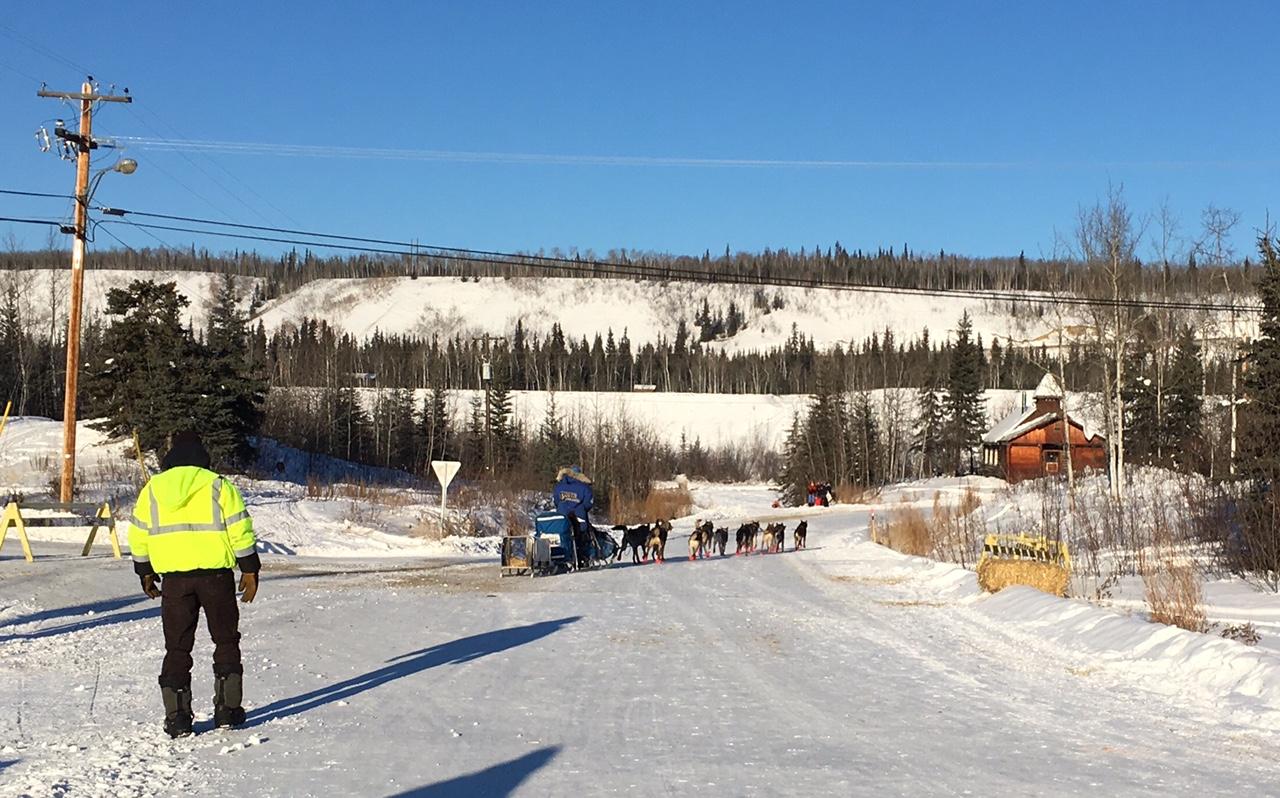
The race is tight between top Yukon Quest mushers, headed toward the race‘s halfway point at Dawson City, Yukon. 2015 Quest champion Brent Sass, defending champion Hugh Neff, veterans Ed Hopkins, and Matt Hall, two-time past winner Allen Moore, and top rookie Katherine Keith, are within about 20 miles of one another along a 105-mile stretch of trail into Dawson. The long remote portion of the race route is a test for mushers beginning to feel the effects of marathon racing.
Matt Hall put foot warmers in his boots at the Pelly Crossing rec center on Monday morning.
“I’m really tired,” Hall said.
The 26-year-old musher had slept about 30 minutes in the past day. When he finished eating a homemade egg scramble, he went back outside to wake up his team. It was about 30 below zero when Hall took off, fourth out of the checkpoint. In the past 48 hours, he had spent maybe six of them inside.
Pelly Crossing is a Selkirk First Nation Village on the Klondike Highway, about a third of the way through the 1,000 mile race. On Monday mushers started showing up to camp in the parking lot. They laid out straw, cooked up steaming pots of meat and kibble, and laid blankets over their dogs. The dogs were fast asleep by the time mushers came inside, ate some chili, and tried to rest for an hour or two in a shared bunk.
At this point of the race, while humans are struggling to stay awake, dogs are just kicking into high gear.
“We’re 250 miles into a race now and I try to stop them and they’re screaming and hitting the line. And it’s like wow if you guys had a week off and we hooked you up, you wouldn’t be this excited to go,” Hall said.
For mushers, trying to stay awake will only get harder as they embark on the longest distance of the race. Dawson City is separated from Pelly by 200 miles of hilly, desolate country. Though Hall is one of the top contenders this year, he said he wasn’t racing to Dawson, where the first musher in wins four ounces of Klondike gold.
“We’ll try to bank a little bit and save for after Dawson I think,” Hall said. “So we’ll let somebody else go for the Dawson gold.”
Paige Drobny rubbed herbal oil onto her dogs’ paws next to the baseball diamond in Pelly. Her team was quietly huddled under colorful blankets and sleeping bags. She said her dogs were also hitting their stride. But she still wanted to give them six hours of rest before the run to Dawson.
“I’m gonna give them a longer rest here, they probably don’t need it, but with a 200 mile section ahead going to Dawson is just a little more than checkpoint to checkpoint,” Drobny said. “I want to make sure they’re more rested and are able to do what I want them to do when I go out there.”
One of Drobny’s young dogs, Chavelle, was helping keep everyone’s spirits up on the trail.
“She squeals,” Drobny said. “She was in lead and there was a big hill that was straight up and we had a little lag there when my sled caught up, she started squealing and everyone barreled down and just drug me up the hill.”
After Pelly, mushers face the Black Hills, a series of steep climbs culminating in 4,000 foot King Solomon’s Dome, the first big summit of the race. They also have really heavy sleds, packed with 200 miles worth of dog food.
Yukon musher Ed Hopkins said it’s important to know your team really well at this point of the race, because you can’t afford to carry your dogs through the next section, if they’re not pulling their own weight.
“Well you better make sure you’ve evaluated your team properly between Carmacks and here before you blow through here right?” Hopkins said. “This is your last spot you can actually see vets and have a chance to look over your team and stuff.”
Hopkins was still recovering from the last run, when he got thrown off his sled by a chunk of jumble ice on the Yukon River. He didn’t even see it coming.
“Maybe I just went over a big chunk of ice, it just offset me, it threw me for a loop, bounced me right out of there, like literally like popcorn,” Hopkins said.
Mushers are required to take a 36-hour layover when they get to Dawson. For the first time, they’re allowed to receive outside help from their handlers, and they can finally get some sleep.




